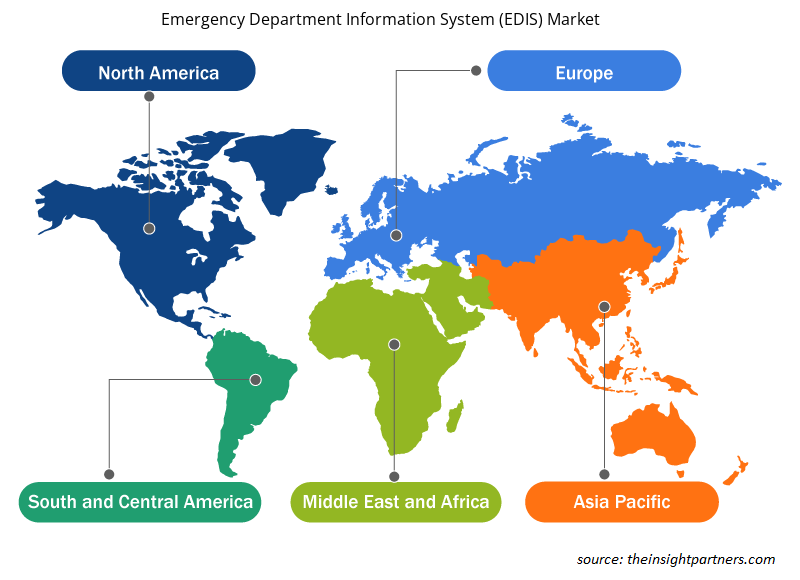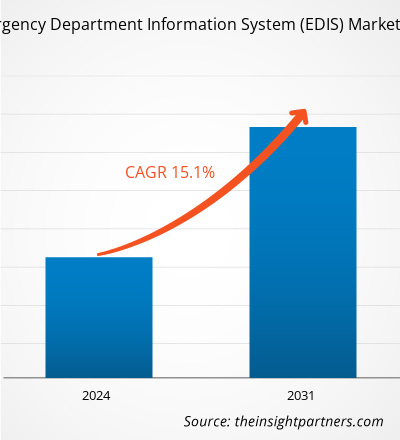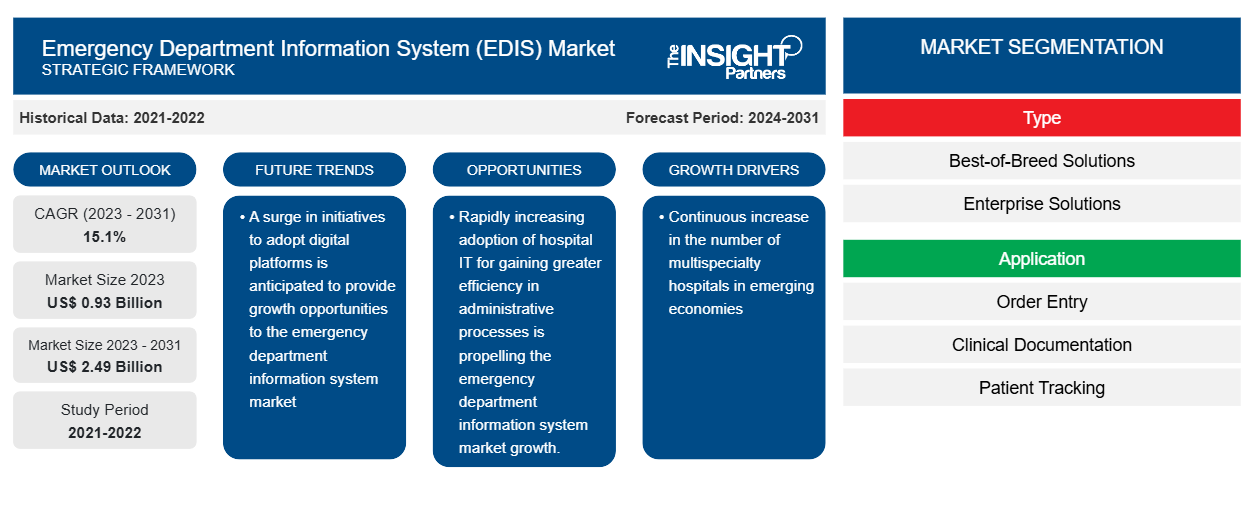Se prevé que el tamaño del mercado de sistemas de información para departamentos de emergencia (EDIS) alcance los 2490 millones de dólares en 2031, frente a los 930 millones de dólares en 2023. Se espera que el mercado registre una CAGR del 15,10 % durante el período 2023-2031. Es probable que la aparición de servicios EDIS basados en la nube siga siendo una tendencia clave en el mercado.
Análisis del mercado de sistemas de información de servicios de urgencias (EDIS)
Los factores clave que impulsan el crecimiento del mercado son el aumento del flujo de pacientes en los servicios de urgencias y la elevada tasa de adopción de sistemas de información para los servicios de urgencias. Además, es probable que el progreso en la digitalización de los servicios sanitarios ofrezca oportunidades al mercado de sistemas de información para los servicios de urgencias (EDIS) en los próximos años.
Descripción general del mercado de sistemas de información de servicios de urgencias (EDIS)
Los servicios médicos de emergencia (EMS) implican la atención aguda de los pacientes. Los departamentos de EMS atienden a pacientes con complicaciones médicas, así como emergencias obstétricas y quirúrgicas. Estos departamentos también tratan lesiones, infecciones, ataques cardíacos , accidentes cerebrovasculares, asma y complicaciones agudas del embarazo. Por lo tanto, se centran principalmente en atender a pacientes con lesiones y enfermedades de emergencia, como accidentes cerebrovasculares y paros cardíacos. Los servicios requeridos en desastres naturales también se incluyen en la categoría de EMS. La demanda de servicios de atención de emergencia en entornos sanitarios está aumentando debido a la creciente incidencia de paros cardíacos y accidentes. Según el Consejo Europeo de Resucitación, la incidencia notificada de paros cardíacos en Europa es de ~67 a 170 por cada 100.000 personas. Según las estimaciones proporcionadas por stroke.org.uk, se espera que la carga de accidentes cerebrovasculares en Europa crezca notablemente en los próximos años. Las proyecciones de este informe indican que habrá un aumento del 34% en el número total de casos de accidente cerebrovascular en la Unión Europea durante el período 2015-2035, ya que es probable que el recuento de casos alcance los 819.771 en 2035 desde los 613.148 en 2015. Por lo tanto, se espera que el flujo de pacientes en los servicios de urgencias aumente en los próximos años.
Personalice este informe según sus necesidades
Obtendrá personalización en cualquier informe, sin cargo, incluidas partes de este informe o análisis a nivel de país, paquete de datos de Excel, así como también grandes ofertas y descuentos para empresas emergentes y universidades.
-
Obtenga las principales tendencias clave del mercado de este informe.Esta muestra GRATUITA incluirá análisis de datos, desde tendencias del mercado hasta estimaciones y pronósticos.
Impulsores y oportunidades del mercado de los sistemas de información de servicios de urgencias (EDIS)
Alta adopción de sistemas de información en servicios de urgencias
Los sistemas de información para departamentos de urgencias (EDIS) mejoran la utilización del personal sanitario y de los recursos, lo que ayuda a gestionar el flujo de pacientes. Los sistemas también ayudan a mejorar la toma de decisiones de los hospitales al proporcionar datos completos en tiempo real para las administraciones hospitalarias. Las soluciones EDIS reducen el coste de las instalaciones sanitarias al reducir los costes laborales. Además, la demanda de sistemas de información para departamentos de urgencias es alta en América del Norte debido a la amplia aceptación de la tecnología en países como Estados Unidos y Canadá. Asimismo, América del Norte domina el mercado mundial de sistemas de información para departamentos de urgencias, seguida de Europa. Europa es conocida por la adopción significativamente creciente de la transformación digital de la atención sanitaria mediante telemática en los entornos sanitarios, junto con el creciente gasto en infraestructura sanitaria y la disponibilidad de dispositivos tecnológicamente avanzados. Además de esto, la adopción cada vez mayor de la TI hospitalaria para obtener una mayor eficiencia en los procesos administrativos está impulsando el crecimiento del mercado de sistemas de información para departamentos de urgencias.EDIS) improve healthcare staff and resource utilization, which helps manage patient flow. The systems also help enhance hospitals’ decision-making by providing comprehensive real-time data for hospital administrations. The EDIS solutions reduce the cost of healthcare facilities by lowering labor costs. Furthermore, the demand for emergency department information systems is high in North America due to the wide acceptance of technology in countries such as the US and Canada. Also, North America dominates the global emergency department information system market, followed by Europe. Europe is known for the significantly rising adoption of telematics healthcare digital transformation in healthcare settings, along with the growing expenditure in healthcare infrastructure and availability of technologically advanced devices. In addition to this, the rapidly increasing adoption of hospital IT to gain greater efficiency in administrative processes is propelling the growth of the emergency department information system market.
Avances en la digitalización de los servicios de saludDigitalization of Healthcare Services
En los últimos años, el proceso de digitalización de los servicios de salud ha ido en aumento con la adopción de la agenda de eSalud agenda en varios países. La eSalud puede mejorar la calidad de los servicios y ayudar a mejorar el acceso de los usuarios a la información sanitaria. También puede ayudar a los proveedores de servicios sanitarios a ahorrar tiempo y reducir la carga de trabajo y los costes asociados a largo plazo. La telesalud, los registros sanitarios electrónicos (EHR), las recetas en línea y los sistemas de información sanitaria se encuentran entre las soluciones digitales que se pueden utilizar en la implementación de la eSalud. La popularidad de las tecnologías digitales como la información sanitaria protegida (PHI) ha aumentado considerablemente en los últimos años. Según los médicos canadienses, el porcentaje de sus pacientes que utilizan tecnologías digitales para gestionar su información médica aumentó del 20,8% en 2017 al 44,7% en 2019.eHealth can enhance the quality of services and aid in improving users' access to health information. It can also help health service providers by saving time and reducing workload and associated costs in the long term. Telehealth, electronic health records (EHR), online prescriptions, and health information systems are among the digital solutions that can be used in the implementation of eHealth. The popularity of digital technologies such as protected health information (PHI) has increased considerably in recent years. According to Canadian physicians, the percentage of their patients using digital technologies to manage their medical information grew from 20.8% in 2017 to 44.7% by 2019.
Análisis de segmentación del informe de mercado del sistema de información de servicios de urgencias (EDIS)EDIS) Market Report Segmentation Analysis
Los segmentos clave que contribuyeron a la derivación del análisis del mercado del sistema de información del departamento de emergencias (EDIS) son el tipo, la aplicación y el usuario final.EDIS) market analysis are type, application, and end user.
- Según el tipo, el mercado de sistemas de información para departamentos de emergencia (EDIS) se segmenta en soluciones de primera categoría y soluciones empresariales. El segmento de kits de soluciones de primera categoría tuvo la participación de mercado más importante en 2023.EDIS) market is segmented into best-of-breed solutions and enterprise solutions. The best-of-breed solutions kits segment held the most significant market share in 2023.
- Según la aplicación, el mercado de sistemas de información para servicios de urgencias (EDIS) está segmentado por entrada de órdenes, documentación clínica, seguimiento de pacientes, prescripción electrónica y otros. El segmento de tratamiento por entrada de órdenes tuvo la mayor participación de mercado en 2023.EDIS) market is segmented by order entry, clinical documentation, patient tracking, e-prescribing, and others. The order entry treatment segment held the largest market share in 2023.
- Según los usuarios finales, el mercado de sistemas de información para departamentos de emergencia (EDIS) está segmentado en hospitales pequeños, hospitales medianos y hospitales grandes. El segmento de hospitales medianos tuvo la mayor participación de mercado en 2023.EDIS) market is segmented by small hospitals, medium-sized hospitals, and large hospitals. The medium-sized hospitals segment held the largest market share in 2023.
Análisis de la cuota de mercado del sistema de información de servicios de urgencias (EDIS) por geografíaEDIS) Market Share Analysis by Geography
El alcance geográfico del informe de mercado del sistema de información del departamento de emergencias (EDIS) se divide principalmente en cinco regiones: América del Norte, Asia Pacífico, Europa, Medio Oriente y África, y América del Sur y Central.
La pandemia de COVID-19 alentó a los departamentos de emergencia de la región a emplear servicios de TI para el cuidado de la salud. Debido al brote, la interoperabilidad, los registros de pacientes vinculados, los datos precisos de los pacientes y la ciberseguridad se han vuelto más importantes que nunca para la salud móvil y los registros médicos electrónicos en el sector de la atención médica. Además, a medida que la población envejece y se vuelve más vulnerable a las enfermedades de larga duración, habrá un aumento en las admisiones hospitalarias y una escalada en la necesidad de sistemas de información para los departamentos de emergencia. Según el Perfil de los estadounidenses mayores de 2020 publicado por la Administración para la Vida en Comunidad, se prevé que el número de estadounidenses mayores de 65 años aumente a 80,58 millones para 2040 y 94,7 millones para 2060.
Perspectivas regionales del mercado del sistema de información de servicios de urgencias (EDIS)
Los analistas de Insight Partners explicaron en detalle las tendencias y los factores regionales que influyen en el mercado de sistemas de información para departamentos de emergencia (EDIS) durante el período de pronóstico. Esta sección también analiza los segmentos y la geografía del mercado de sistemas de información para departamentos de emergencia (EDIS) en América del Norte, Europa, Asia Pacífico, Oriente Medio y África, y América del Sur y Central.

- Obtenga datos específicos regionales para el mercado del Sistema de información de servicios de urgencias (EDIS)
Alcance del informe de mercado del sistema de información de servicios de urgencias (EDIS)
| Atributo del informe | Detalles |
|---|---|
| Tamaño del mercado en 2023 | 0,93 mil millones de dólares estadounidenses |
| Tamaño del mercado en 2031 | US$ 2,49 mil millones |
| CAGR global (2023 - 2031) | 15,1% |
| Datos históricos | 2021-2022 |
| Período de pronóstico | 2024-2031 |
| Segmentos cubiertos |
Por tipo
|
| Regiones y países cubiertos |
América del norte
|
| Líderes del mercado y perfiles de empresas clave |
|
Densidad de actores del mercado del sistema de información de servicios de urgencias (EDIS): comprensión de su impacto en la dinámica empresarial
El mercado de sistemas de información para departamentos de emergencia (EDIS) está creciendo rápidamente, impulsado por la creciente demanda de los usuarios finales debido a factores como la evolución de las preferencias de los consumidores, los avances tecnológicos y una mayor conciencia de los beneficios del producto. A medida que aumenta la demanda, las empresas amplían sus ofertas, innovan para satisfacer las necesidades de los consumidores y aprovechan las tendencias emergentes, lo que impulsa aún más el crecimiento del mercado.
La densidad de actores del mercado se refiere a la distribución de las empresas o firmas que operan dentro de un mercado o industria en particular. Indica cuántos competidores (actores del mercado) están presentes en un espacio de mercado determinado en relación con su tamaño o valor total de mercado.
Las principales empresas que operan en el mercado de sistemas de información de departamentos de emergencia (EDIS) son:
- Allscripts Salud LLC
- Corporación Cerner
- Tecnología de salud electrónica
- Corporación de sistemas épicos
- Tecnología de información médica, Inc.
- Q-nomy, Inc
Descargo de responsabilidad : Las empresas enumeradas anteriormente no están clasificadas en ningún orden particular.

- Obtenga una descripción general de los principales actores clave del mercado del Sistema de información del departamento de emergencias (EDIS)
Noticias del mercado y desarrollos recientes del sistema de información de servicios de urgencias (EDIS)
El mercado de sistemas de información para departamentos de emergencias (EDIS) se evalúa mediante la recopilación de datos cualitativos y cuantitativos posteriores a la investigación primaria y secundaria, que incluye publicaciones corporativas importantes, datos de asociaciones y bases de datos. A continuación, se enumeran algunos de los desarrollos en el mercado de sistemas de información para departamentos de emergencias (EDIS):
- Augmedix anunció la disponibilidad general de Augmedix Go para los departamentos de emergencias (ED), lo que marca el lanzamiento del primer producto de documentación médica totalmente automatizado y basado en inteligencia artificial generativa (GenAI) de la industria para los ED de todo el país. (Fuente: Augmedix, sitio web de la empresa, abril de 2024)
Informe de mercado sobre el sistema de información de servicios de urgencias (EDIS) y resultados finales
El informe “Tamaño y pronóstico del mercado del sistema de información del departamento de emergencias (EDIS) (2021-2031)” proporciona un análisis detallado del mercado que cubre las siguientes áreas:
- Tamaño del mercado del sistema de información del departamento de emergencias (EDIS) y pronóstico a nivel global, regional y nacional para todos los segmentos clave del mercado cubiertos bajo el alcance
- Tendencias del mercado de sistemas de información para departamentos de emergencia (EDIS), así como dinámicas del mercado, como impulsores, restricciones y oportunidades clave
- Análisis detallado de las cinco fuerzas de Porter y PEST y FODA
- Análisis del mercado del sistema de información del departamento de emergencias (EDIS) que cubre las tendencias clave del mercado, el marco global y regional, los principales actores, las regulaciones y los desarrollos recientes del mercado.
- Análisis del panorama de la industria y de la competencia que abarca la concentración del mercado, el análisis de mapas de calor, los actores destacados y los desarrollos recientes para el mercado de sistemas de información de departamentos de emergencia (EDIS)
- Perfiles detallados de empresas
- Análisis histórico (2 años), año base, pronóstico (7 años) con CAGR
- Análisis PEST y FODA
- Tamaño del mercado, valor/volumen: global, regional y nacional
- Industria y panorama competitivo
- Conjunto de datos de Excel
Informes recientes
Testimonios
Razón para comprar
- Toma de decisiones informada
- Comprensión de la dinámica del mercado
- Análisis competitivo
- Información sobre clientes
- Pronósticos del mercado
- Mitigación de riesgos
- Planificación estratégica
- Justificación de la inversión
- Identificación de mercados emergentes
- Mejora de las estrategias de marketing
- Impulso de la eficiencia operativa
- Alineación con las tendencias regulatorias























 Obtenga una muestra gratuita para - Mercado del Sistema de Información del Departamento de Emergencias (EDIS)
Obtenga una muestra gratuita para - Mercado del Sistema de Información del Departamento de Emergencias (EDIS)